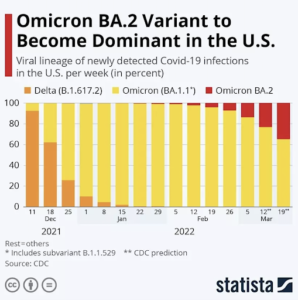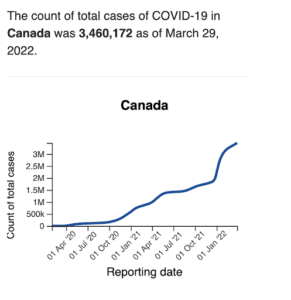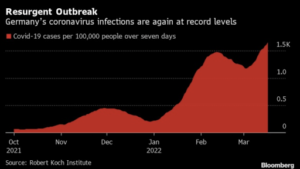Are we nearing the end of the Pandemic?
March 31, 2022
By Ryan M. Thomas
Over the last month, we’ve seen COVID-19 restrictions continue to shift worldwide. Government funding for surveillance tools, testing, as well as vaccine and treatment research has declined, and it seems as though the governments of the world have declared the pandemic over.
It was last week that I came across an open letter penned by America’s leading medical experts in The New York Times that articulates the concerns we’ve previously raised.
Authored by U.S. Surgeon General, Dr. Murthy, and Dr. Kessler, Chief Science Officer of the U.S. COVID-19 Response Team, the medical leaders address Congress’ decision to reduce funds allocated to the country’s COVID-19 response efforts.
Decreasing funds for testing, vaccine research, virus surveillance tools, and antivirals (including reducing access to monoclonal antibodies by 35% which are important for the treatment of COVID-19 in severe cases) has relayed to the world that the U.S.’s fight against existing, and emerging, COVID-19 strains, is ending.
This move has sent a concerning message to the scientific and medical communities worldwide. But just as the U.S’s medical leaders have written, the inability to act quickly and swiftly to monitor new strains effectively, administer tests, and allocate funds to provide new vaccines in the fall of 2022 – when a resurgence is anticipated to occur—puts the immunocompromised and the vulnerable at risk.

Figure source: World Economic Forum
Worldwide Easing of Restrictions
The United States is one example of governments worldwide that are rescinding their COVID-19 response efforts.
And yet, this comes at a time when the novel COVID-19 strain of concern, BA.2 (aka “Stealth Omicron”), has been reported to be gaining ground throughout the world (the dominant BA.2 variant has been reported by the World Health Organization to represent 86% of all sequenced cases globally, and is more transmissible than its highly contagious Omicron siblings, BA.1, and BA.1.1). The prevalence of a new strain is predicted to cause a new wave as spring is ushered in, Canadian health experts say.

Figure source: Government of Canada
In places like Germany and France, novel strains are also raising concern once again, with hospital and infection rates advancing to new record levels. And in places like China’s Shanghai, city-wide lock-downs have been reinstated due to a rapid increase in infectivity rates.
This strongly indicates that the pandemic is far from over, especially for those unvaccinated, and the immuno-compromised. As the world’s restrictions ease, I also can’t help but think that we are once again repeating previous mistakes: lowering our guard to only to have to scramble to respond to a new variant causing another wave or surge.

Figure source: BNN Bloomberg
“There are three kinds of lies: Lies, Damned Lies, and Statistics,” Mark Twain.
Over the last 12 months, we’ve seen definitions change of how to define a positive case, how to define a Covid hospitalization, and now we’re seeing definition changes for what constitutes a Covid death and also of the CDC’s Covid Risk Formula to identify communities of high transmission.
Over time, we should aim for more precise and exact definitions. The issue, of course, arises when it’s used to manipulate future data to make it appear better than past data. With the CDC’s update to the Covid Risk Formula, the vast majority of the US went from high risk to low-medium risk overnight just by adjusting the denominator of the formula. If this is a more accurate representation of the true risk, then we should applaud the move, and use it to adjust past data so that it can be easily comparable.
We’ve previously noted important changes to how cases are counted, to levels of sensitivity for PCR tests, and new data required to more accurately count a hospitalization. These new changes make comparing historical data impossible and limits our ability to accurately compare the present state of the pandemic to the past.
Is the Pandemic Over?
With many of these changes negatively affecting our ability to monitor the spread of the pandemic, I’ve begun to wonder about the age-old folklore: if a tree falls in the forest, and there’s no one around to hear it, did it truly make a sound?
The cutting of funding, the changing of definitions, and the lowering of restrictions all put us in a more vulnerable position where we’re less able to “hear if the tree falls.”
While we all want to eagerly turn the page and accept the end-of-pandemic narrative, the virus has not disappeared, it is not less contagious or even less pathogenic, and new evidence has emerged, since we warned in January about spillover and spillback events, that there are increasing numbers of species who have been infected by Covid, and additional studies have emerged identifying large mutations in Covid from these events.
It is clear that now more than ever, the world requires a ready-to-market, pan-coronavirus mRNA vaccine to ward off existing and new strains of COVID-19, promote herd immunity, and decrease rates of infection worldwide. And at Eyam, our mission remains the same: to provide just that.
Are we nearing the end of the Pandemic?
March 31, 2022
By Ryan M. Thomas
Over the last month, we’ve seen COVID-19 restrictions continue to shift worldwide. Government funding for surveillance tools, testing, as well as vaccine and treatment research has declined, and it seems as though the governments of the world have declared the pandemic over.
It was last week that I came across an open letter penned by America’s leading medical experts in The New York Times that articulates the concerns we’ve previously raised.
Authored by U.S. Surgeon General, Dr. Murthy, and Dr. Kessler, Chief Science Officer of the U.S. COVID-19 Response Team, the medical leaders address Congress’ decision to reduce funds allocated to the country’s COVID-19 response efforts.
Decreasing funds for testing, vaccine research, virus surveillance tools, and antivirals (including reducing access to monoclonal antibodies by 35% which are important for the treatment of COVID-19 in severe cases) has relayed to the world that the U.S.’s fight against existing, and emerging, COVID-19 strains, is ending.
This move has sent a concerning message to the scientific and medical communities worldwide. But just as the U.S’s medical leaders have written, the inability to act quickly and swiftly to monitor new strains effectively, administer tests, and allocate funds to provide new vaccines in the fall of 2022 – when a resurgence is anticipated to occur—puts the immunocompromised and the vulnerable at risk.

Figure source: World Economic Forum
Worldwide Easing of Restrictions
The United States is one example of governments worldwide that are rescinding their COVID-19 response efforts.
And yet, this comes at a time when the novel COVID-19 strain of concern, BA.2 (aka “Stealth Omicron”), has been reported to be gaining ground throughout the world (the dominant BA.2 variant has been reported by the World Health Organization to represent 86% of all sequenced cases globally, and is more transmissible than its highly contagious Omicron siblings, BA.1, and BA.1.1). The prevalence of a new strain is predicted to cause a new wave as spring is ushered in, Canadian health experts say.

Figure source: Government of Canada
In places like Germany and France, novel strains are also raising concern once again, with hospital and infection rates advancing to new record levels. And in places like China’s Shanghai, city-wide lock-downs have been reinstated due to a rapid increase in infectivity rates.
This strongly indicates that the pandemic is far from over, especially for those unvaccinated, and the immuno-compromised. As the world’s restrictions ease, I also can’t help but think that we are once again repeating previous mistakes: lowering our guard to only to have to scramble to respond to a new variant causing another wave or surge.

Figure source: BNN Bloomberg
“There are three kinds of lies: Lies, Damned Lies, and Statistics,” Mark Twain.
Over the last 12 months, we’ve seen definitions change of how to define a positive case, how to define a Covid hospitalization, and now we’re seeing definition changes for what constitutes a Covid death and also of the CDC’s Covid Risk Formula to identify communities of high transmission.
Over time, we should aim for more precise and exact definitions. The issue, of course, arises when it’s used to manipulate future data to make it appear better than past data. With the CDC’s update to the Covid Risk Formula, the vast majority of the US went from high risk to low-medium risk overnight just by adjusting the denominator of the formula. If this is a more accurate representation of the true risk, then we should applaud the move, and use it to adjust past data so that it can be easily comparable.
We’ve previously noted important changes to how cases are counted, to levels of sensitivity for PCR tests, and new data required to more accurately count a hospitalization. These new changes make comparing historical data impossible and limits our ability to accurately compare the present state of the pandemic to the past.
Is the Pandemic Over?
With many of these changes negatively affecting our ability to monitor the spread of the pandemic, I’ve begun to wonder about the age-old folklore: if a tree falls in the forest, and there’s no one around to hear it, did it truly make a sound?
The cutting of funding, the changing of definitions, and the lowering of restrictions all put us in a more vulnerable position where we’re less able to “hear if the tree falls.”
While we all want to eagerly turn the page and accept the end-of-pandemic narrative, the virus has not disappeared, it is not less contagious or even less pathogenic, and new evidence has emerged, since we warned in January about spillover and spillback events, that there are increasing numbers of species who have been infected by Covid, and additional studies have emerged identifying large mutations in Covid from these events.
It is clear that now more than ever, the world requires a ready-to-market, pan-coronavirus mRNA vaccine to ward off existing and new strains of COVID-19, promote herd immunity, and decrease rates of infection worldwide. And at Eyam, our mission remains the same: to provide just that.






